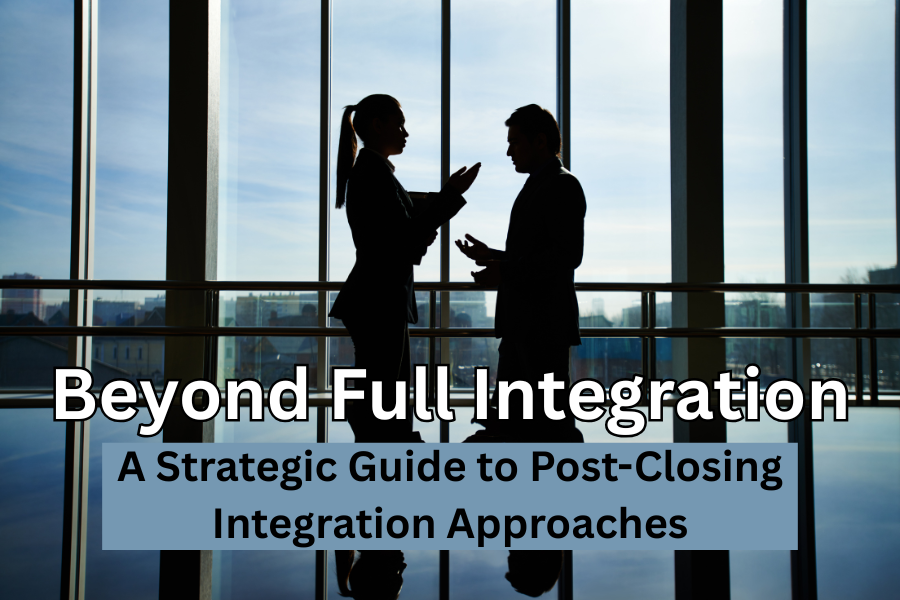Beyond Full Integration: A Strategic Guide to Post-Closing Integration Approaches
When most executives think about post-closing integration, they default to one approach: immediate, comprehensive integration of the acquired company. This "rip the band-aid off" mentality has become so ingrained in M&A thinking that many leaders fail to realize they may be leaving value on the table by not considering alternative strategies.
The reality is that full integration from day one is just one option in a spectrum of strategic approaches. The key to successful M&A outcomes lies in matching your integration strategy to your specific deal objectives, market conditions, and organizational capabilities.
The Full Integration Myth
The prevailing wisdom suggests that faster integration equals better results. This thinking stems from the desire to capture synergies quickly and eliminate redundancies. While this approach can work well in certain scenarios—particularly when acquiring direct competitors or when significant cost synergies are the primary value driver—it's not always the optimal path.
Full integration can actually destroy value when it disrupts successful business models, alienates key talent, or overwhelms the acquiring organization's capacity for change. Sometimes the very qualities that made the target attractive in the first place can be lost in an aggressive integration process.
The Integration Strategy Spectrum
Smart acquirers recognize that integration exists on a spectrum, with multiple viable approaches depending on the deal's strategic rationale:
No Integration (Standalone Approach)
In this model, the acquired company continues operating independently while benefiting from the parent company's resources and strategic guidance. This approach works particularly well when the target has a successful business model that shouldn't be disrupted, operates in a different market segment, or when the acquisition was made for portfolio diversification rather than operational synergies.
Financial holding companies often use this approach, allowing subsidiaries to maintain their entrepreneurial culture and market responsiveness while providing capital and strategic oversight.
Partial Integration (Selective Integration)
This strategy involves integrating specific functions while keeping others separate. Common areas for selective integration include back-office functions like finance and HR, shared services, or specific product lines where synergies are most apparent.
Technology companies often employ this approach, integrating R&D efforts and sales channels while maintaining separate product development teams to preserve their innovation capabilities.
Phased Integration (Step-by-Step Approach)
Rather than attempting everything at once, phased integration spreads the process over months or years. This allows organizations to learn from early integration efforts, build capabilities, and manage change more effectively.
The phased approach typically begins with low-risk areas, such as shared services, and then progresses to more complex operational integrations as teams gain experience and confidence.
Delayed Integration (Strategic Patience)
Sometimes the best integration strategy is to wait. This approach allows the acquired company to continue operating independently while both organizations prepare for eventual integration. This waiting period can be used to gain a better understanding of the target's business model, develop integration capabilities, or wait for more favorable market conditions.
Delayed integration is particularly valuable when acquiring companies in unfamiliar markets or when the acquiring organization is already managing multiple change initiatives.
Choosing the Right Approach
The optimal integration strategy depends on several key factors:
Deal Rationale: If you acquired the company for its unique capabilities or market position, aggressive integration might destroy the very value you sought to capture. If cost synergies were the primary driver, more comprehensive integration may be necessary.
Cultural Compatibility: Organizations with vastly different cultures may benefit from a slower integration approach that allows time for cultural bridge-building and mutual understanding.
Market Dynamics: In rapidly changing markets, maintaining the target's agility and market responsiveness might be more valuable than achieving short-term synergies.
Organizational Capacity: Honest assessment of your organization's change management capabilities should inform the pace and scope of integration efforts. Overwhelming your teams rarely leads to successful outcomes.
Stakeholder Considerations: Key customers, employees, and partners of the acquired company may react differently to various integration approaches. Understanding these dynamics is crucial for strategy selection.
Implementation Success Factors
Regardless of which integration approach you choose, several factors consistently drive success:
Clear Communication: Stakeholders need to understand not just what's happening, but why specific integration decisions were made. Transparency about the chosen strategy helps manage expectations and reduces uncertainty.
Dedicated Resources: Integration requires dedicated leadership and resources. Part-time integration efforts typically deliver part-time results.
Cultural Sensitivity: Even in no-integration scenarios, understanding and respecting the acquired company's culture is essential for maintaining performance and engagement.
Flexibility: Integration strategies should evolve based on learning and changing circumstances. What seems right at closing may need adjustment as you gain a deeper understanding of the business.
Success Metrics: Define clear metrics for your chosen integration approach. Success in a phased integration looks different from success in immediate full integration.
The Strategic Advantage
Organizations that master the full spectrum of integration approaches gain a significant competitive advantage in M&A. They can pursue a broader range of acquisition opportunities because they're not limited to deals that fit a single integration model.
This strategic flexibility also allows for more accurate deal pricing, as the integration approach can be factored into value creation projections from the earliest stages of deal evaluation.
Moving Forward
The next time you're planning post-closing integration, resist the urge to default to full integration simply because it's familiar. Instead, take time to evaluate which approach best serves your strategic objectives while preserving the value that made the acquisition attractive in the first place.
Remember that successful integration isn't about speed or comprehensiveness—it's about choosing the right approach for your specific situation and executing it with discipline and care. Sometimes the best integration strategy is the one that integrates the least.


